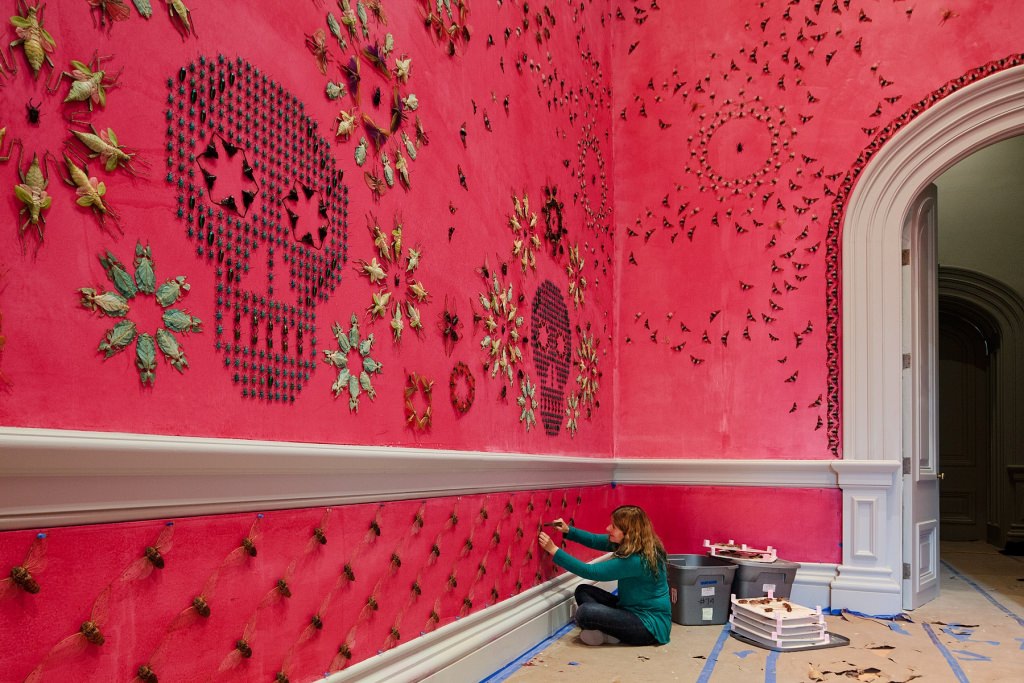Fall Competition aims to set standard for research excellence

Jennifer Angus, a past recipient of a Fall Research Competition Award, exhibited at the Smithsonian Institution last fall. Her exhibit, “Wonder,” featured real insects that are not endangered, but are quite abundant, primarily in Malaysia, Thailand and Papua New Guinea. The pink wash is derived from the cochineal insect living on cacti in Mexico. Photo courtesy of Jennifer Angus
Fall brings a lot of competition to the UW–Madison campus. For sports fans, thoughts might turn to football or volleyball. But for researchers, it signals the annual Fall Research Competition.
Through the Fall Research Competition, the Office of the Vice Chancellor for Research and Graduate Education aims to set high standards for research excellence. The competition offers funding for cutting-edge faculty research and support for graduate students who may be involved in that research.
“We often hear from award recipients that the Fall Research Competition is instrumental in allowing them to delve into a new line or research and generate preliminary data that will lead to extramural grant applications for larger-scale research projects,” says Marsha Mailick, vice chancellor for research and graduate education. “The projects are widely varied and represent the breadth of scholarly endeavors taking place at UW–Madison. The Fall Research Competition allows us to provide our researchers with critical resources they need to be successful.”
Funding for the competition comes from the Wisconsin Alumni Research Foundation (WARF), which was created in 1925 to help commercialize technology arising from UW–Madison research. Since then, WARF has provided the university with more than $1.5 billion for research, programs and initiatives.
“WARF’s generous support for the Fall Research Competition again this year, and for many other initiatives of UW–Madison, gives our university a significant margin of excellence that propels innovation, creativity and discovery by faculty, students and staff,” Mailick notes.
Each year, four research committees representing UW–Madison’s faculty divisions — biological sciences, physical sciences, social studies, and the arts and humanities — review about 500 research proposals from faculty representing 120 different departments and fund about 57 percent of those proposals.
Ryan J. Herringa, assistant professor of child and adolescent psychiatry, received a Fall Research Competition Award in 2014-15. His study, “Neural Substrates of Fear Processing in Pediatric Post-Traumatic Stress Disorder,” is ongoing with plans for clinical applications.
“We are studying how children learn fear and safety reactions from their parents,” Herringa says. “We think this is part of what is driving anxiety and PTSD. We are piloting this new paradigm in healthy children and their moms.”
Herringa hopes that by better understanding how the brain works differently in youth with PTSD, there will one day be improved detection and better treatment of post-traumatic stress in youth.
Jennifer Angus, professor of design studies and affiliate faculty in the Art Department, received a Fall Research Competition Award for a project that generated national and international attention for its results.
“Support from the annual Fall Research Competition funded by WARF has allowed me to take on more and more ambitious projects,” says Angus. “In the fall of 2015, ‘Wonder,’ the inaugural exhibition that celebrates the reopening of the Smithsonian’s Renwick Gallery (after a two-year closure for a major renovation) opened to rave reviews. I was one of nine artists selected for this landmark exhibition. I could not have reached this level of acclaim without the support I’ve received.”
Nicholas Bell, the exhibition’s curator, estimated that during the six month run of the exhibition some 500,000 people visited the museum.
All requests for 2016-17 research support from the Fall Research Competition must be submitted electronically to the Office of the VCRGE by 4:30 p.m. Friday, Sept. 23, 2016.




